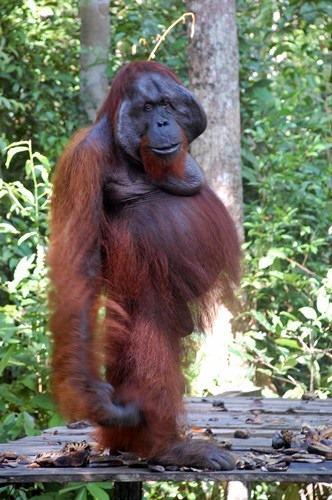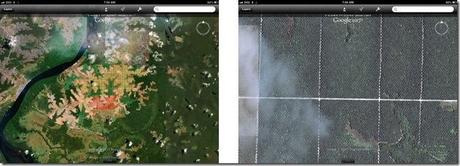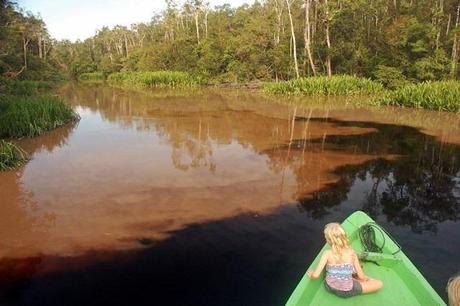
A reminder that we're related
We knew our trip up the river from Kumai would be a privileged experience, to see wild, exotic and endangered animals- the Borneo orangutan in particular. What we didn’t expect is how tangibly we’d find the evidence of threats against these creatures and their habitat.What’s happening
Orangutans in the wild are now limited to Sumatra, and Borneo (an island shared by Indonesia, Malaysia, and Brunei). Their habitat is rapidly being lost, primarily as a result of pressure from logging for timber, and to develop palm oil plantations. In addition to the obvious habitat destruction, plantation developers put a bounty on the heads of orangs and the (also endangered) proboscis monkey- despite their protected status under Indonesian law. To a lesser extent, orangs are also targeted by poachers for the exotic pet trade and by migrant workers for food. Without meaningful effort to address these threats, orangutans are predicted to be extinct in the wild in 10 to 20 years.
That is the briefest of summaries for a more complex issue. See here and here if you’d like to read more.
What we saw
Before we arrived, Google Earth gave us a sobering picture of the landscape- an unexpected view that came sharply into focus as I was caching images of the area to help our navigation. The sharply geometric patterns of palm oil plantations are impossible to miss. Zoom in on areas with high-resolution coverage and you can literally see every tree.

Our first day in the river heading north, we were passed by a huge barge loaded with massive trees. We saw several more during just a few days in the river. It could have been logged legally, which is tragic enough given the pace of deforestation (80% gone from Borneo in the last 20 years, and this is the worlds third largest island), but it is entirely possible that the logs they weren’t- 70% of timber in Indonesia is believed to be illegally taken. The volume was staggering, and this is just one of many, many river-highways in Borneo.

We also saw much sawdust and the debris of timber milling in the water as we cruised around the Borneo coast. Rivers, too, that act as the highways to carry logs would carry silty water far out to sea. Some silting is normal, but the dramatic shifts in color change (it is literally a line in the water at the point where it meets the ocean). Rainforest soil is actually relatively poor, and the erosion process is swift. It also changed the charted depths as debris is carried out and settles on the seabed. Near river outflows, we sailed through areas charted at 40-50’ but saw no more than 20’ for hours. These charts are less than ten years old, and thanks to the commercial traffic, are more carefully drafted than most areas of Indonesia
The WWF also has a graphic depicting the loss of forests in Borneo. The few areas they expect to be remaining in less than ten years are those which don’t make good habitable for orangs.
Mining also threatens the area, too. We’re informed at Camp Leakey about a gold mine upriver. There’s a sharp change in water color between this river, and the branch that extends up to Leakey. This silting is attributed to the mine. The stark shift from milky, silted water with the mining runoff meets the clear, inky waters of the tannic- but clean- tributary.

Siobhan watches the clean tributary to Camp Leakey meet the mine run-off pollution
Mercury, used in the mining process, also taints the water, although we see local boats fishing. I struggle to understand how this “illegal” mine is so well known- it is referenced in signage at Camp Leakey, most of which appears to be at least a decade old. It’s in the descriptions of the area online. Why isn’t anything done about it? Indonesia has systemic issues with corruption, although it has made tremendous progress to improve the record under the current president, “SBY”- Susilo Bambang Yudhoyono, an acknowledged corruption buster at high levels. It is simply pervasive.
Why you should care
Hopefully, saving one of the five great apes- and the only one to reside in Asia- from extinction is enough.
Orangutans aside, the issue plaguing their survival affects ours as well. The tropical forests being destroyed contain staggering diversity in both plant and animal life, far surpassing temperate forests. The value held in these incredibly diverse environments is uncertain, but the potential is overwhelming. Medical treatments for cancer or AIDs, anyone?
The vehicle for much of the forest destruction, and for rural farming in the area, is burning. Thanks to massive burns to clear land for palm oil plantations and as part of the slash-and-burn agriculture, Indonesia has earned a place as one of the world’s largest contributors of carbon to the atmosphere. Borneo is the third largest island in the world, and
The people of the region need a sustainable options for their own livelihood. Many are desperately poor, and really have no choice except to fully participate in illegal and unsustainable practices.
Now what?
What can you do? Voting with our wallets is the one of the most powerful tools of the consumer. Don’t buy products with palm oil. This is going to be very, very difficult. Palm oil goes by many names (including the generic “vegetable oil”)- but it’s probably even in your shampoo and toothpaste and liquid soap as Sodium Lauryl Sulfate. One statistic I read indicated 50% of consumer products in the UK contain palm oil. That’s staggering, but it’s very cheap to produce.
If that sounds draconian, then make a point of selecting products from companies that are working towards transparency and sustainability in palm oil farming. Use the wallet vote to put pressure on: we were told the palm oil plantation that is immediately adjacent to the forest where we saw orangs is owned by an American company. Which one? Who do they supply?
The uncomfortable fact is that we do need oil and palm oil is actually a really great source: it is very high yielding in terms of production per land area. It’s chemically diverse, in a good way. The problem, though, is that demand for this cheap, rich oil is decimating native rainforests. There are organizations which promote sustainable palm oil farming: this is the logical direction to go, and a more thoughtful option to support people who live in Borneo. There is a Round Table on Sustainable Palm Oil Farming, with a lot of big names in the consumer packaged goods arena on board. I just am very, very well conditioned to be skeptical of those big names and their actual motivation (Nestle, is a signatory, which kind of says it all to me). But the positive work of getting palm oil properly labeled on products can help educate consumers to purchase alternatives and promote for sustainability in the industry. Sydney’s awesome Taronga Zoo has more information.
Our kids have jumped with both feet into a boycott of products with palm oil on Totem. We looked through packages of consumer goods on board, and were stunned at how prevalent palm oil is on the ingredient label. It’s probably even worse than we realize, because palm oil goes by many names.
We will have some sad goodbyes (palm oil is a major ingredient in Nutella- noooooo!), but the kids are adamant, and I’m proud of them. It made my provisioning efforts in Kuching yesterday very difficult: there was not a single brand of crackers or cookies that did not contain palm oil. Not one.
Visit Borneo. This is by far the most enjoyable option, if you can afford it! It will blow you away. Tourism gives people sustainable work, and can put pressure upon the local and national administrators to do the right thing. This is especially important as in 2014, the management of Tanjung Puting national park will be transitioned away from the role currently played by The Orangutan Foundation, and into Indonesian hands. Nobody we spoke with- our guides, the employees in the parks, the other visitors- sees any positive outcome from that transition, unfortunately. I saw photos of timber that had been illegally logged being transported right through the national park where we visited- and this happens everywhere in Borneo, where plantations abut the meager areas of preserved land. With more eyeballs, and more attention, this is less likely to occur. Outside interest and attention makes it a lot harder for a corrupt deal to steal more of the forest, and education is one of the most important things the rehabilitation centers can do.
Whew. OK, this was not the typical post from the happy campers sailing Totem around the world. But it was important, and after our experience, there were things I just had to say- had to share.
I promise, we’ll be back to more happy pictures of our family cruising in the next post. Like the awesome shrunken heads the guy showed us at a traditional Bornean smokehouse. Wow.

